Revaluation of Fixed Assets
VerifiedAdded on 2020/05/16
|10
|1483
|124
AI Summary
This assignment focuses on the revaluation of fixed assets within two factories, one in NSW and one in QLD. It presents the initial carrying amounts for land and buildings, then outlines journal entries to record an increase in the carrying amount of buildings in NSW due to revaluation. The document also details a subsequent journal entry reflecting a loss on revaluation for the QLD factory's assets.
Contribute Materials
Your contribution can guide someone’s learning journey. Share your
documents today.
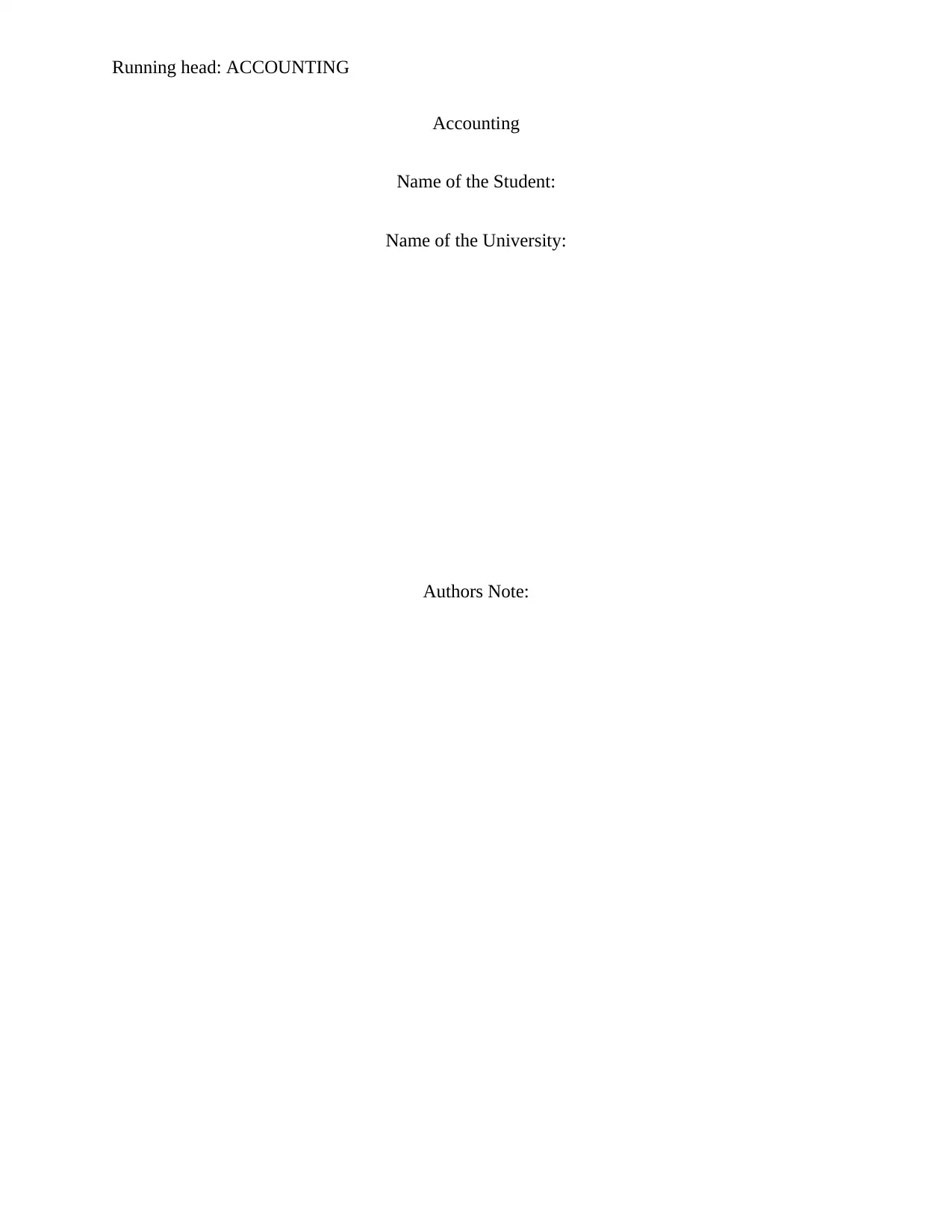
Running head: ACCOUNTING
Accounting
Name of the Student:
Name of the University:
Authors Note:
Accounting
Name of the Student:
Name of the University:
Authors Note:
Secure Best Marks with AI Grader
Need help grading? Try our AI Grader for instant feedback on your assignments.
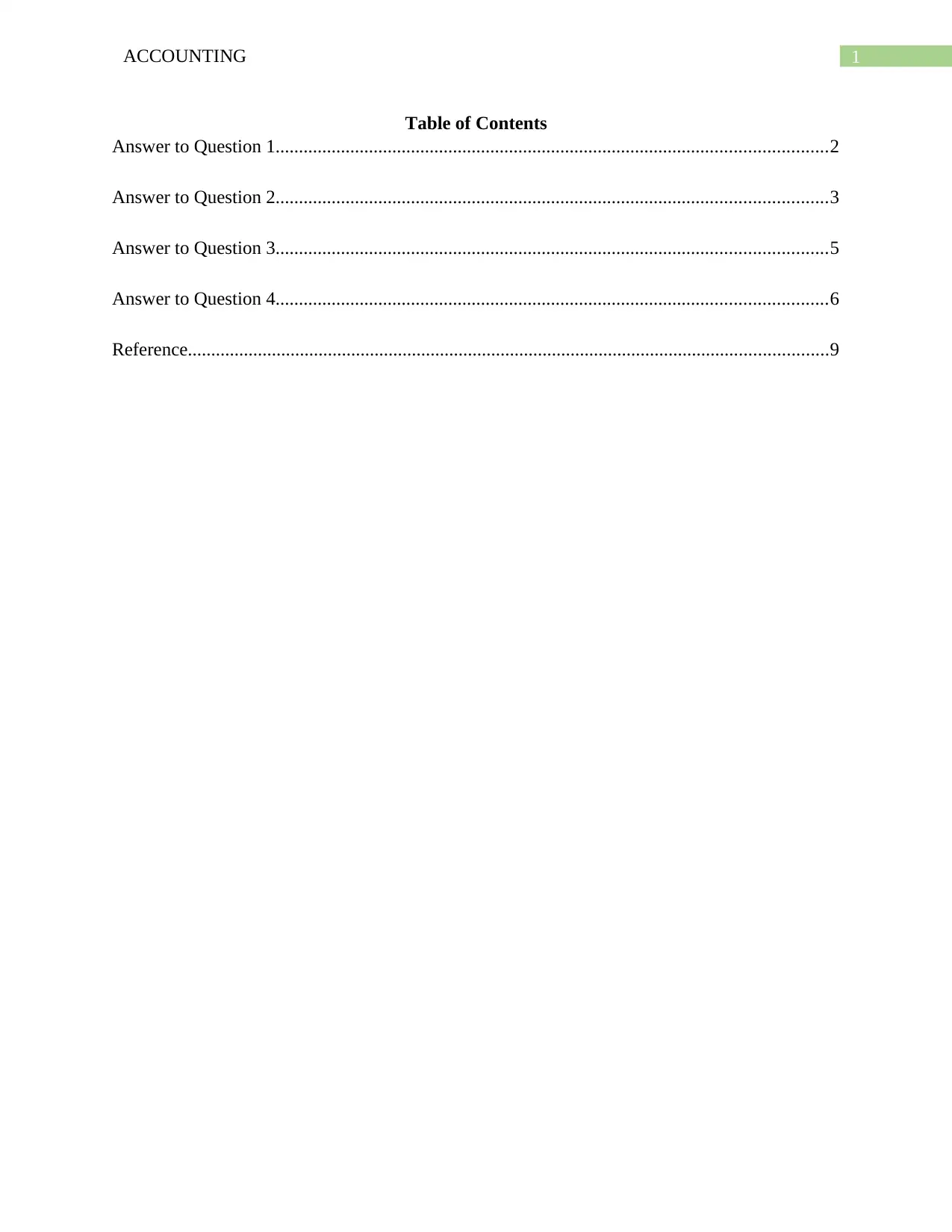
1ACCOUNTING
Table of Contents
Answer to Question 1......................................................................................................................2
Answer to Question 2......................................................................................................................3
Answer to Question 3......................................................................................................................5
Answer to Question 4......................................................................................................................6
Reference.........................................................................................................................................9
Table of Contents
Answer to Question 1......................................................................................................................2
Answer to Question 2......................................................................................................................3
Answer to Question 3......................................................................................................................5
Answer to Question 4......................................................................................................................6
Reference.........................................................................................................................................9
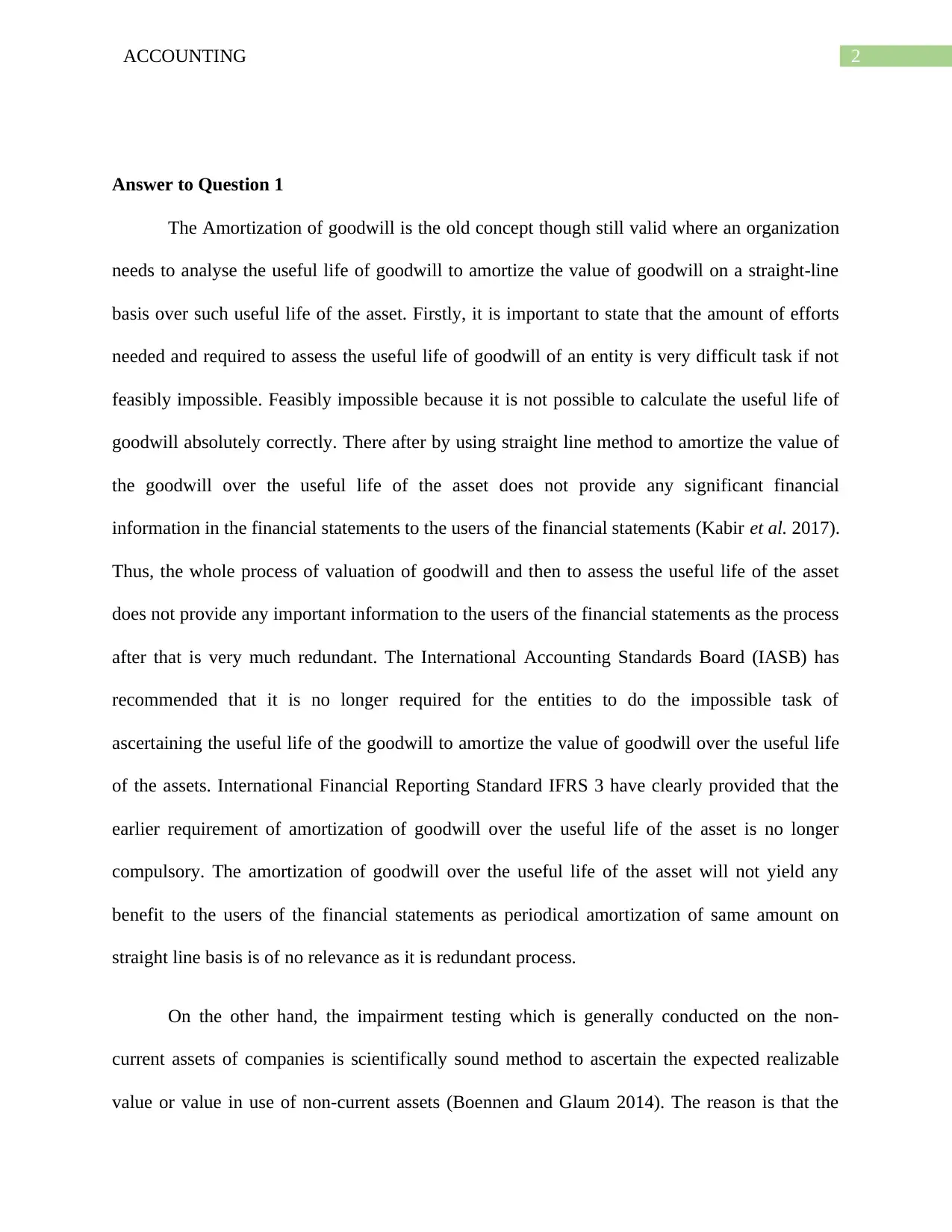
2ACCOUNTING
Answer to Question 1
The Amortization of goodwill is the old concept though still valid where an organization
needs to analyse the useful life of goodwill to amortize the value of goodwill on a straight-line
basis over such useful life of the asset. Firstly, it is important to state that the amount of efforts
needed and required to assess the useful life of goodwill of an entity is very difficult task if not
feasibly impossible. Feasibly impossible because it is not possible to calculate the useful life of
goodwill absolutely correctly. There after by using straight line method to amortize the value of
the goodwill over the useful life of the asset does not provide any significant financial
information in the financial statements to the users of the financial statements (Kabir et al. 2017).
Thus, the whole process of valuation of goodwill and then to assess the useful life of the asset
does not provide any important information to the users of the financial statements as the process
after that is very much redundant. The International Accounting Standards Board (IASB) has
recommended that it is no longer required for the entities to do the impossible task of
ascertaining the useful life of the goodwill to amortize the value of goodwill over the useful life
of the assets. International Financial Reporting Standard IFRS 3 have clearly provided that the
earlier requirement of amortization of goodwill over the useful life of the asset is no longer
compulsory. The amortization of goodwill over the useful life of the asset will not yield any
benefit to the users of the financial statements as periodical amortization of same amount on
straight line basis is of no relevance as it is redundant process.
On the other hand, the impairment testing which is generally conducted on the non-
current assets of companies is scientifically sound method to ascertain the expected realizable
value or value in use of non-current assets (Boennen and Glaum 2014). The reason is that the
Answer to Question 1
The Amortization of goodwill is the old concept though still valid where an organization
needs to analyse the useful life of goodwill to amortize the value of goodwill on a straight-line
basis over such useful life of the asset. Firstly, it is important to state that the amount of efforts
needed and required to assess the useful life of goodwill of an entity is very difficult task if not
feasibly impossible. Feasibly impossible because it is not possible to calculate the useful life of
goodwill absolutely correctly. There after by using straight line method to amortize the value of
the goodwill over the useful life of the asset does not provide any significant financial
information in the financial statements to the users of the financial statements (Kabir et al. 2017).
Thus, the whole process of valuation of goodwill and then to assess the useful life of the asset
does not provide any important information to the users of the financial statements as the process
after that is very much redundant. The International Accounting Standards Board (IASB) has
recommended that it is no longer required for the entities to do the impossible task of
ascertaining the useful life of the goodwill to amortize the value of goodwill over the useful life
of the assets. International Financial Reporting Standard IFRS 3 have clearly provided that the
earlier requirement of amortization of goodwill over the useful life of the asset is no longer
compulsory. The amortization of goodwill over the useful life of the asset will not yield any
benefit to the users of the financial statements as periodical amortization of same amount on
straight line basis is of no relevance as it is redundant process.
On the other hand, the impairment testing which is generally conducted on the non-
current assets of companies is scientifically sound method to ascertain the expected realizable
value or value in use of non-current assets (Boennen and Glaum 2014). The reason is that the
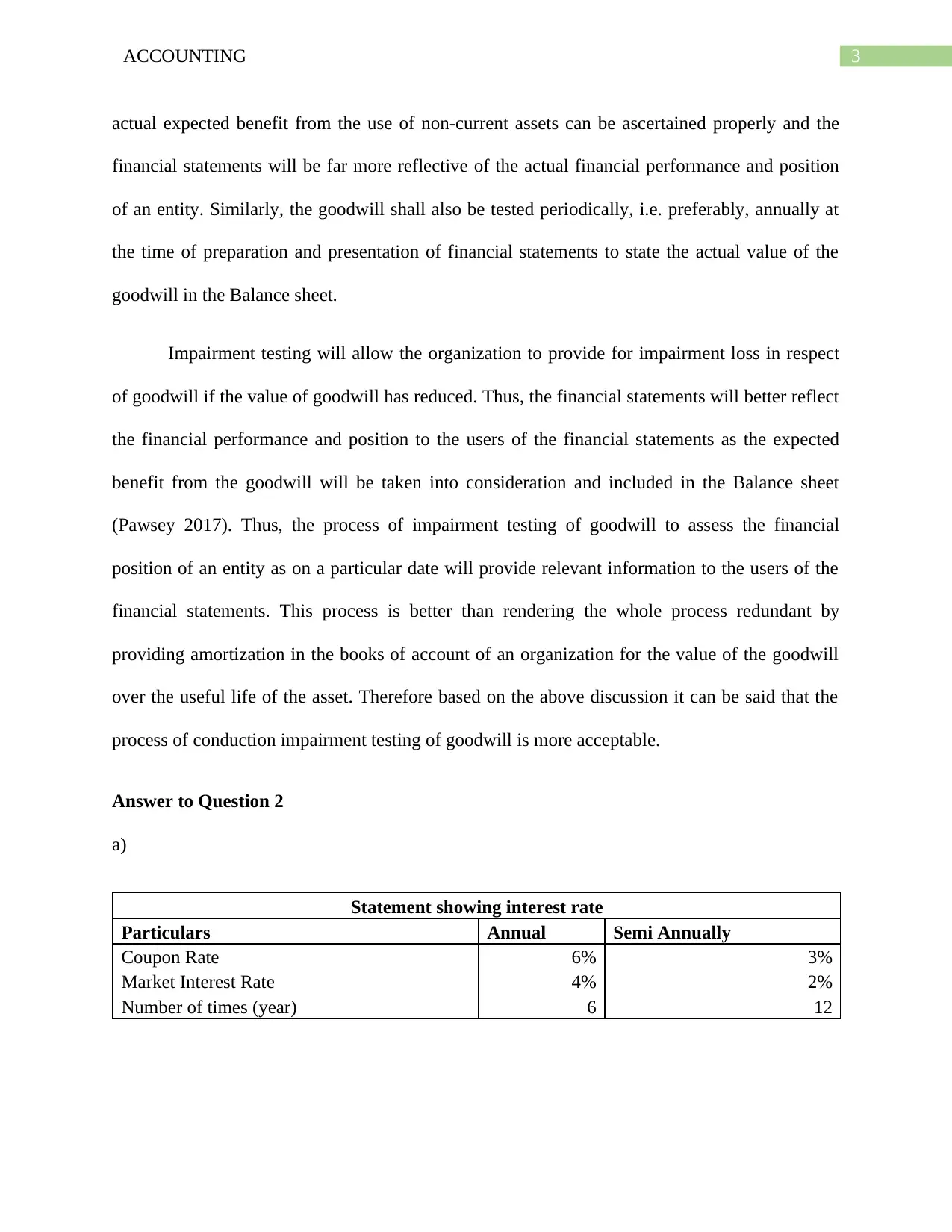
3ACCOUNTING
actual expected benefit from the use of non-current assets can be ascertained properly and the
financial statements will be far more reflective of the actual financial performance and position
of an entity. Similarly, the goodwill shall also be tested periodically, i.e. preferably, annually at
the time of preparation and presentation of financial statements to state the actual value of the
goodwill in the Balance sheet.
Impairment testing will allow the organization to provide for impairment loss in respect
of goodwill if the value of goodwill has reduced. Thus, the financial statements will better reflect
the financial performance and position to the users of the financial statements as the expected
benefit from the goodwill will be taken into consideration and included in the Balance sheet
(Pawsey 2017). Thus, the process of impairment testing of goodwill to assess the financial
position of an entity as on a particular date will provide relevant information to the users of the
financial statements. This process is better than rendering the whole process redundant by
providing amortization in the books of account of an organization for the value of the goodwill
over the useful life of the asset. Therefore based on the above discussion it can be said that the
process of conduction impairment testing of goodwill is more acceptable.
Answer to Question 2
a)
Statement showing interest rate
Particulars Annual Semi Annually
Coupon Rate 6% 3%
Market Interest Rate 4% 2%
Number of times (year) 6 12
actual expected benefit from the use of non-current assets can be ascertained properly and the
financial statements will be far more reflective of the actual financial performance and position
of an entity. Similarly, the goodwill shall also be tested periodically, i.e. preferably, annually at
the time of preparation and presentation of financial statements to state the actual value of the
goodwill in the Balance sheet.
Impairment testing will allow the organization to provide for impairment loss in respect
of goodwill if the value of goodwill has reduced. Thus, the financial statements will better reflect
the financial performance and position to the users of the financial statements as the expected
benefit from the goodwill will be taken into consideration and included in the Balance sheet
(Pawsey 2017). Thus, the process of impairment testing of goodwill to assess the financial
position of an entity as on a particular date will provide relevant information to the users of the
financial statements. This process is better than rendering the whole process redundant by
providing amortization in the books of account of an organization for the value of the goodwill
over the useful life of the asset. Therefore based on the above discussion it can be said that the
process of conduction impairment testing of goodwill is more acceptable.
Answer to Question 2
a)
Statement showing interest rate
Particulars Annual Semi Annually
Coupon Rate 6% 3%
Market Interest Rate 4% 2%
Number of times (year) 6 12
Secure Best Marks with AI Grader
Need help grading? Try our AI Grader for instant feedback on your assignments.
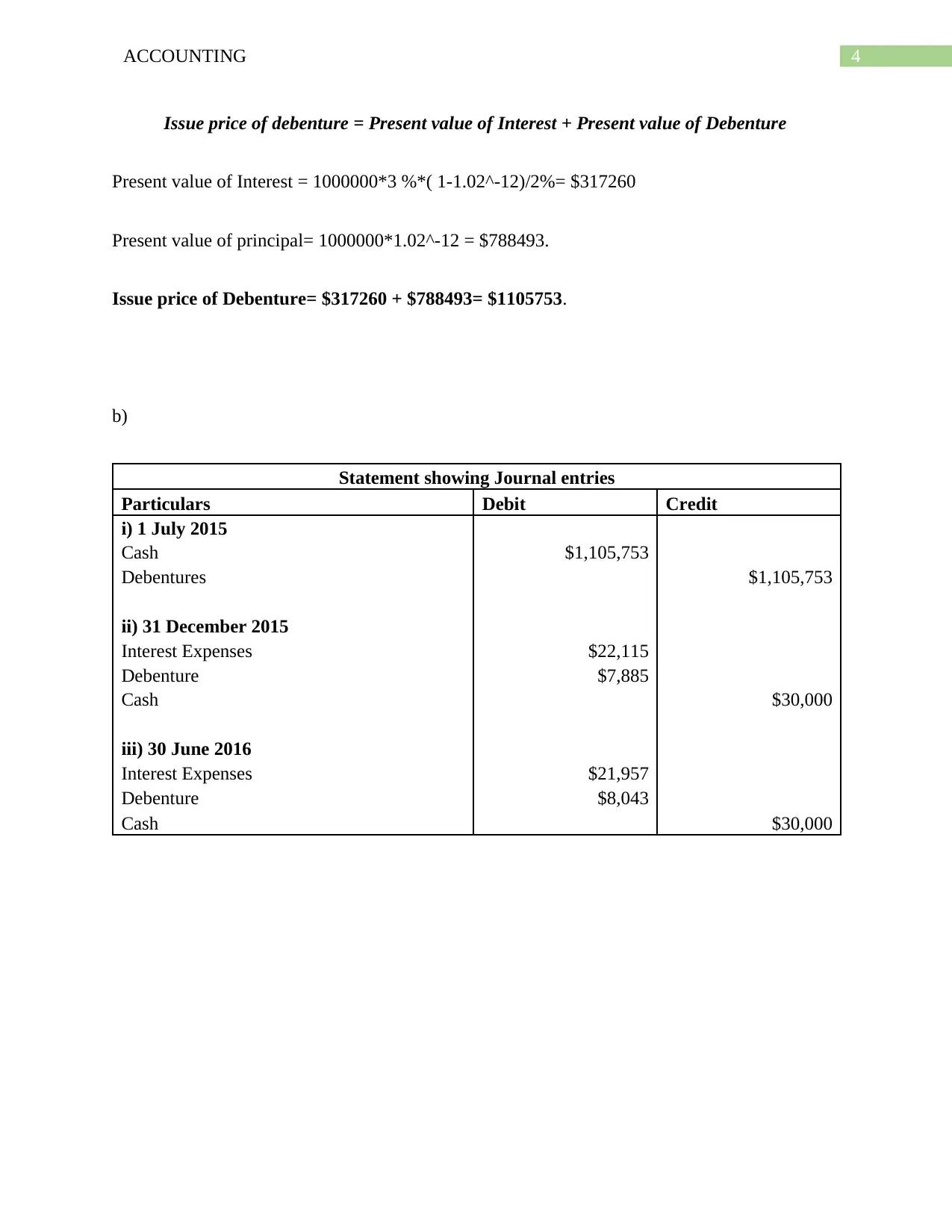
4ACCOUNTING
Issue price of debenture = Present value of Interest + Present value of Debenture
Present value of Interest = 1000000*3 %*( 1-1.02^-12)/2%= $317260
Present value of principal= 1000000*1.02^-12 = $788493.
Issue price of Debenture= $317260 + $788493= $1105753.
b)
Statement showing Journal entries
Particulars Debit Credit
i) 1 July 2015
Cash $1,105,753
Debentures $1,105,753
ii) 31 December 2015
Interest Expenses $22,115
Debenture $7,885
Cash $30,000
iii) 30 June 2016
Interest Expenses $21,957
Debenture $8,043
Cash $30,000
Issue price of debenture = Present value of Interest + Present value of Debenture
Present value of Interest = 1000000*3 %*( 1-1.02^-12)/2%= $317260
Present value of principal= 1000000*1.02^-12 = $788493.
Issue price of Debenture= $317260 + $788493= $1105753.
b)
Statement showing Journal entries
Particulars Debit Credit
i) 1 July 2015
Cash $1,105,753
Debentures $1,105,753
ii) 31 December 2015
Interest Expenses $22,115
Debenture $7,885
Cash $30,000
iii) 30 June 2016
Interest Expenses $21,957
Debenture $8,043
Cash $30,000
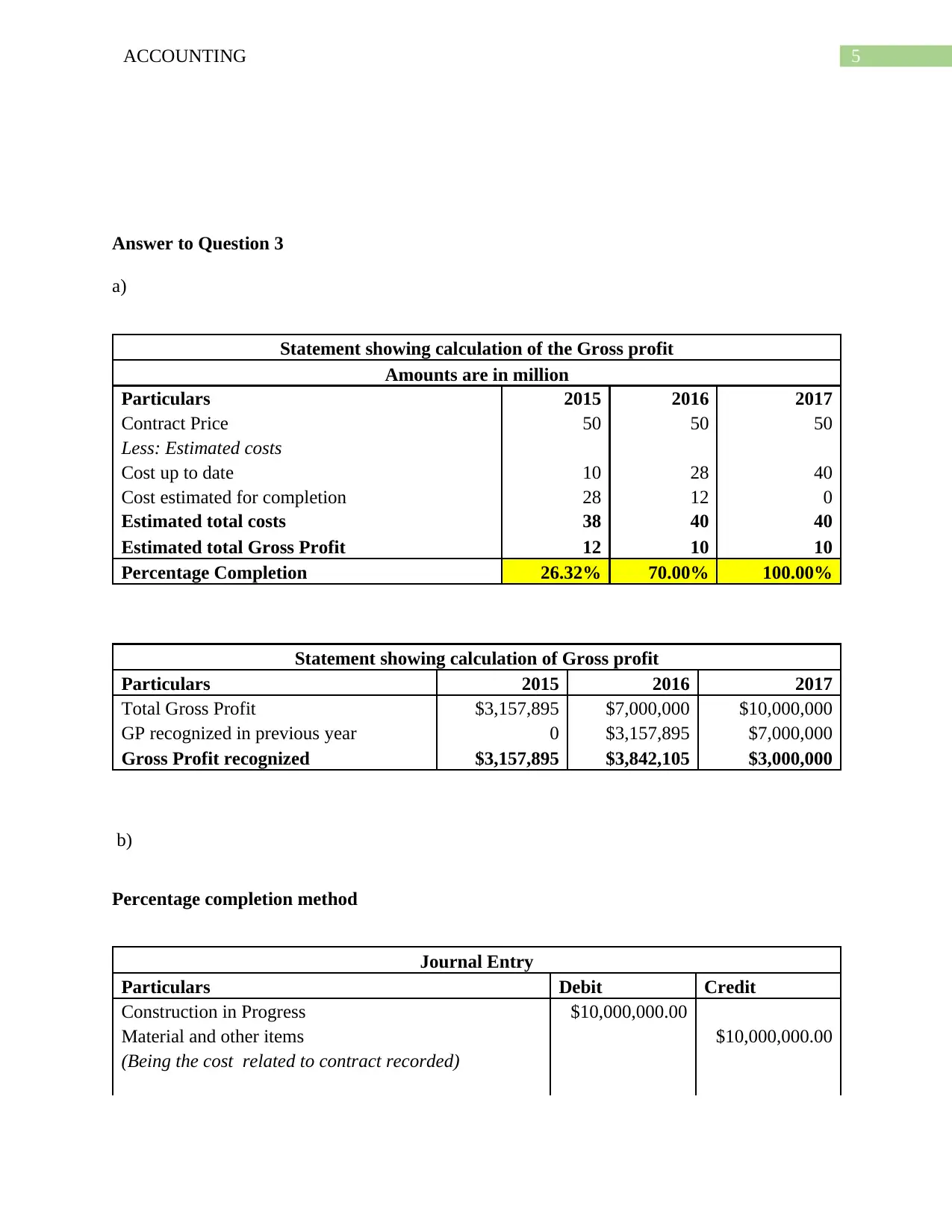
5ACCOUNTING
Answer to Question 3
a)
Statement showing calculation of the Gross profit
Amounts are in million
Particulars 2015 2016 2017
Contract Price 50 50 50
Less: Estimated costs
Cost up to date 10 28 40
Cost estimated for completion 28 12 0
Estimated total costs 38 40 40
Estimated total Gross Profit 12 10 10
Percentage Completion 26.32% 70.00% 100.00%
Statement showing calculation of Gross profit
Particulars 2015 2016 2017
Total Gross Profit $3,157,895 $7,000,000 $10,000,000
GP recognized in previous year 0 $3,157,895 $7,000,000
Gross Profit recognized $3,157,895 $3,842,105 $3,000,000
b)
Percentage completion method
Journal Entry
Particulars Debit Credit
Construction in Progress $10,000,000.00
Material and other items $10,000,000.00
(Being the cost related to contract recorded)
Answer to Question 3
a)
Statement showing calculation of the Gross profit
Amounts are in million
Particulars 2015 2016 2017
Contract Price 50 50 50
Less: Estimated costs
Cost up to date 10 28 40
Cost estimated for completion 28 12 0
Estimated total costs 38 40 40
Estimated total Gross Profit 12 10 10
Percentage Completion 26.32% 70.00% 100.00%
Statement showing calculation of Gross profit
Particulars 2015 2016 2017
Total Gross Profit $3,157,895 $7,000,000 $10,000,000
GP recognized in previous year 0 $3,157,895 $7,000,000
Gross Profit recognized $3,157,895 $3,842,105 $3,000,000
b)
Percentage completion method
Journal Entry
Particulars Debit Credit
Construction in Progress $10,000,000.00
Material and other items $10,000,000.00
(Being the cost related to contract recorded)
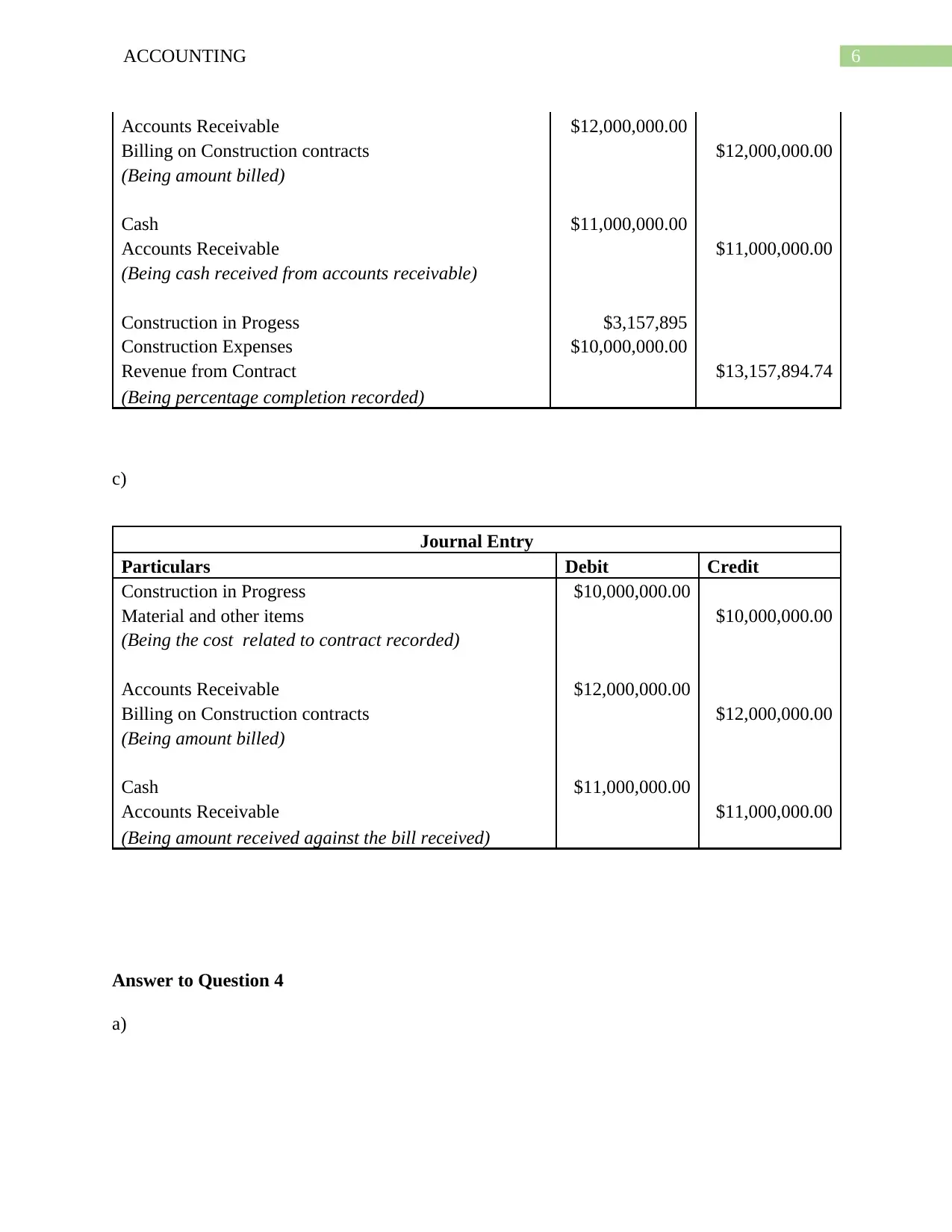
6ACCOUNTING
Accounts Receivable $12,000,000.00
Billing on Construction contracts $12,000,000.00
(Being amount billed)
Cash $11,000,000.00
Accounts Receivable $11,000,000.00
(Being cash received from accounts receivable)
Construction in Progess $3,157,895
Construction Expenses $10,000,000.00
Revenue from Contract $13,157,894.74
(Being percentage completion recorded)
c)
Journal Entry
Particulars Debit Credit
Construction in Progress $10,000,000.00
Material and other items $10,000,000.00
(Being the cost related to contract recorded)
Accounts Receivable $12,000,000.00
Billing on Construction contracts $12,000,000.00
(Being amount billed)
Cash $11,000,000.00
Accounts Receivable $11,000,000.00
(Being amount received against the bill received)
Answer to Question 4
a)
Accounts Receivable $12,000,000.00
Billing on Construction contracts $12,000,000.00
(Being amount billed)
Cash $11,000,000.00
Accounts Receivable $11,000,000.00
(Being cash received from accounts receivable)
Construction in Progess $3,157,895
Construction Expenses $10,000,000.00
Revenue from Contract $13,157,894.74
(Being percentage completion recorded)
c)
Journal Entry
Particulars Debit Credit
Construction in Progress $10,000,000.00
Material and other items $10,000,000.00
(Being the cost related to contract recorded)
Accounts Receivable $12,000,000.00
Billing on Construction contracts $12,000,000.00
(Being amount billed)
Cash $11,000,000.00
Accounts Receivable $11,000,000.00
(Being amount received against the bill received)
Answer to Question 4
a)
Paraphrase This Document
Need a fresh take? Get an instant paraphrase of this document with our AI Paraphraser
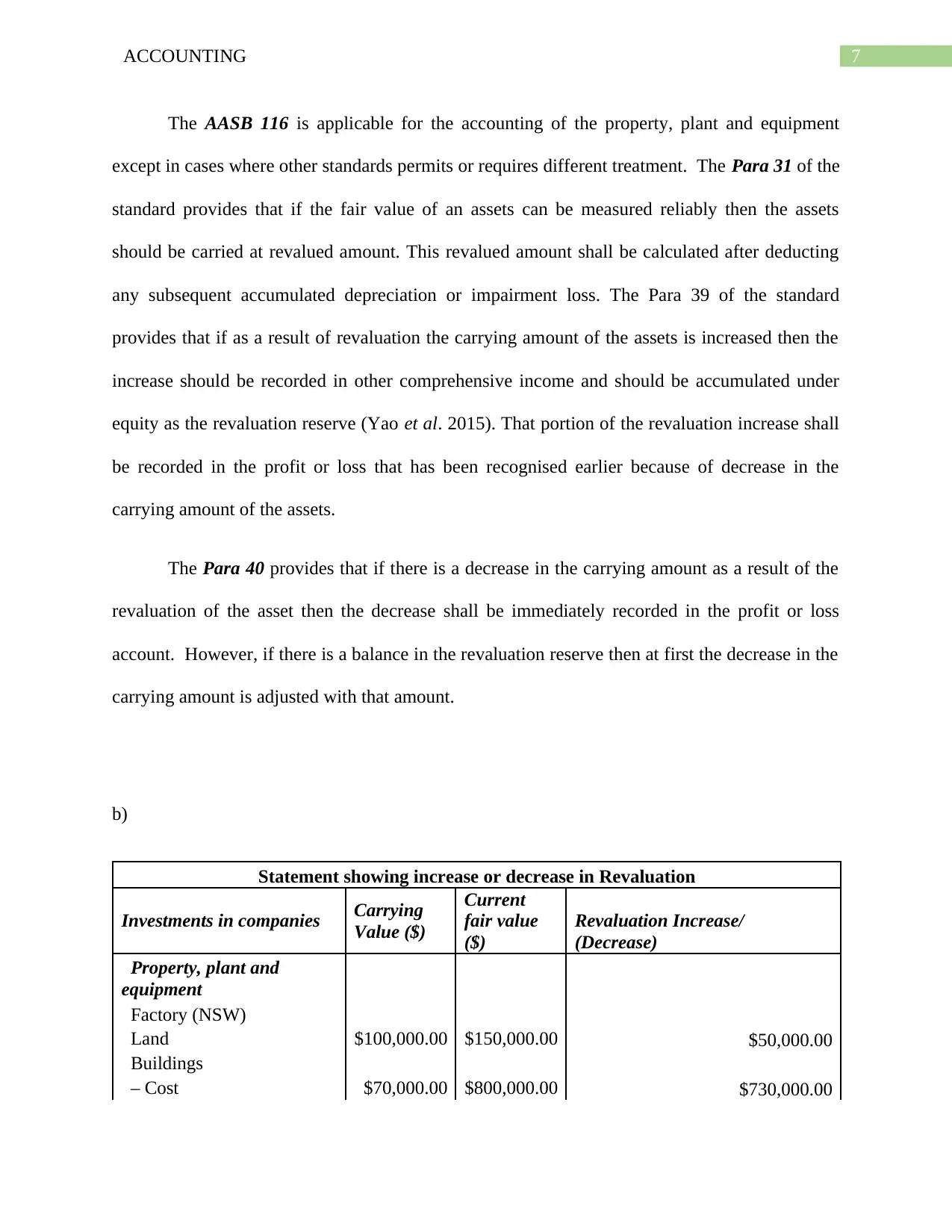
7ACCOUNTING
The AASB 116 is applicable for the accounting of the property, plant and equipment
except in cases where other standards permits or requires different treatment. The Para 31 of the
standard provides that if the fair value of an assets can be measured reliably then the assets
should be carried at revalued amount. This revalued amount shall be calculated after deducting
any subsequent accumulated depreciation or impairment loss. The Para 39 of the standard
provides that if as a result of revaluation the carrying amount of the assets is increased then the
increase should be recorded in other comprehensive income and should be accumulated under
equity as the revaluation reserve (Yao et al. 2015). That portion of the revaluation increase shall
be recorded in the profit or loss that has been recognised earlier because of decrease in the
carrying amount of the assets.
The Para 40 provides that if there is a decrease in the carrying amount as a result of the
revaluation of the asset then the decrease shall be immediately recorded in the profit or loss
account. However, if there is a balance in the revaluation reserve then at first the decrease in the
carrying amount is adjusted with that amount.
b)
Statement showing increase or decrease in Revaluation
Investments in companies Carrying
Value ($)
Current
fair value
($)
Revaluation Increase/
(Decrease)
Property, plant and
equipment
Factory (NSW)
Land $100,000.00 $150,000.00 $50,000.00
Buildings
– Cost $70,000.00 $800,000.00 $730,000.00
The AASB 116 is applicable for the accounting of the property, plant and equipment
except in cases where other standards permits or requires different treatment. The Para 31 of the
standard provides that if the fair value of an assets can be measured reliably then the assets
should be carried at revalued amount. This revalued amount shall be calculated after deducting
any subsequent accumulated depreciation or impairment loss. The Para 39 of the standard
provides that if as a result of revaluation the carrying amount of the assets is increased then the
increase should be recorded in other comprehensive income and should be accumulated under
equity as the revaluation reserve (Yao et al. 2015). That portion of the revaluation increase shall
be recorded in the profit or loss that has been recognised earlier because of decrease in the
carrying amount of the assets.
The Para 40 provides that if there is a decrease in the carrying amount as a result of the
revaluation of the asset then the decrease shall be immediately recorded in the profit or loss
account. However, if there is a balance in the revaluation reserve then at first the decrease in the
carrying amount is adjusted with that amount.
b)
Statement showing increase or decrease in Revaluation
Investments in companies Carrying
Value ($)
Current
fair value
($)
Revaluation Increase/
(Decrease)
Property, plant and
equipment
Factory (NSW)
Land $100,000.00 $150,000.00 $50,000.00
Buildings
– Cost $70,000.00 $800,000.00 $730,000.00
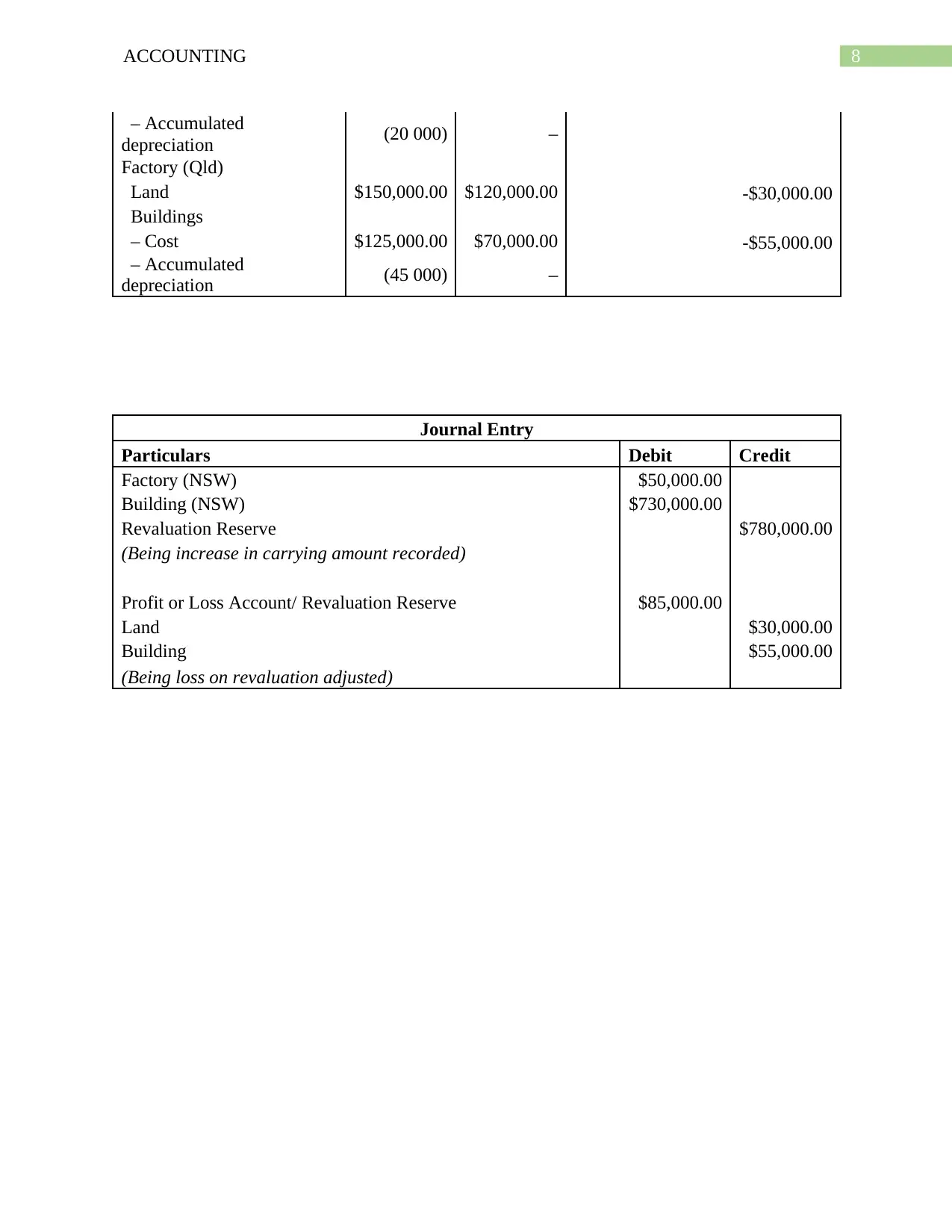
8ACCOUNTING
– Accumulated
depreciation (20 000) –
Factory (Qld)
Land $150,000.00 $120,000.00 -$30,000.00
Buildings
– Cost $125,000.00 $70,000.00 -$55,000.00
– Accumulated
depreciation (45 000) –
Journal Entry
Particulars Debit Credit
Factory (NSW) $50,000.00
Building (NSW) $730,000.00
Revaluation Reserve $780,000.00
(Being increase in carrying amount recorded)
Profit or Loss Account/ Revaluation Reserve $85,000.00
Land $30,000.00
Building $55,000.00
(Being loss on revaluation adjusted)
– Accumulated
depreciation (20 000) –
Factory (Qld)
Land $150,000.00 $120,000.00 -$30,000.00
Buildings
– Cost $125,000.00 $70,000.00 -$55,000.00
– Accumulated
depreciation (45 000) –
Journal Entry
Particulars Debit Credit
Factory (NSW) $50,000.00
Building (NSW) $730,000.00
Revaluation Reserve $780,000.00
(Being increase in carrying amount recorded)
Profit or Loss Account/ Revaluation Reserve $85,000.00
Land $30,000.00
Building $55,000.00
(Being loss on revaluation adjusted)
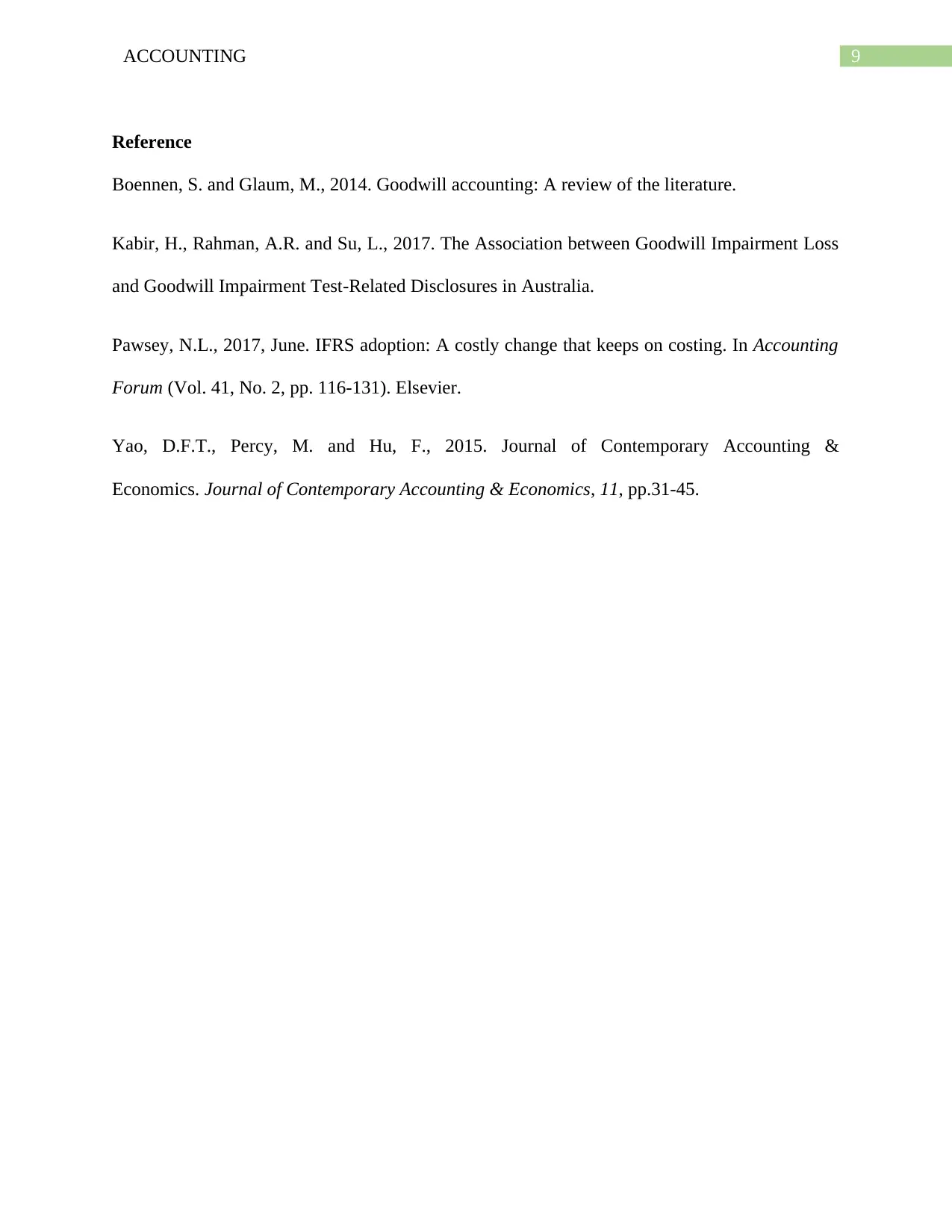
9ACCOUNTING
Reference
Boennen, S. and Glaum, M., 2014. Goodwill accounting: A review of the literature.
Kabir, H., Rahman, A.R. and Su, L., 2017. The Association between Goodwill Impairment Loss
and Goodwill Impairment Test-Related Disclosures in Australia.
Pawsey, N.L., 2017, June. IFRS adoption: A costly change that keeps on costing. In Accounting
Forum (Vol. 41, No. 2, pp. 116-131). Elsevier.
Yao, D.F.T., Percy, M. and Hu, F., 2015. Journal of Contemporary Accounting &
Economics. Journal of Contemporary Accounting & Economics, 11, pp.31-45.
Reference
Boennen, S. and Glaum, M., 2014. Goodwill accounting: A review of the literature.
Kabir, H., Rahman, A.R. and Su, L., 2017. The Association between Goodwill Impairment Loss
and Goodwill Impairment Test-Related Disclosures in Australia.
Pawsey, N.L., 2017, June. IFRS adoption: A costly change that keeps on costing. In Accounting
Forum (Vol. 41, No. 2, pp. 116-131). Elsevier.
Yao, D.F.T., Percy, M. and Hu, F., 2015. Journal of Contemporary Accounting &
Economics. Journal of Contemporary Accounting & Economics, 11, pp.31-45.
1 out of 10
Related Documents
Your All-in-One AI-Powered Toolkit for Academic Success.
+13062052269
info@desklib.com
Available 24*7 on WhatsApp / Email
![[object Object]](/_next/static/media/star-bottom.7253800d.svg)
Unlock your academic potential
© 2024 | Zucol Services PVT LTD | All rights reserved.





